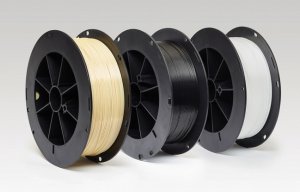
SABIC debuts new high-performance filaments at RAPID + TCT
The company is launching its new Lexan EXL AMHI240F filament, a product for fused deposition modelling delivering high impact performance.

14th November 2017
Innovation in Textiles
|
Frankfurt
Sabic is demonstrating its strong focus on advancing additive manufacturing from prototyping to full-scale production at this week’s Formnext 2017, in Frankfurt. The company is launching its new Lexan EXL AMHI240F filament, a product for fused deposition modelling that is said to deliver high impact performance and low-temperature ductility. Lexan EXL filament supplements the filament portfolio that the company launched earlier this year and is displaying at its Formnext stand.
The company is also introducing to the European market a product family of eight reinforced compounds for large format additive manufacturing. Further illustrating its emphasis on disruptive technologies, Sabic is highlighting several other distinctive solutions for additive manufacturing.
“Expansion of additive manufacturing depends on the availability of high-performance materials that can help optimize processing and promote application innovation,” said Stephanie Gathman, director, Emerging Applications, Sabic.
“Sabic is creating a range of new materials for different additive manufacturing processes, and supporting customers with our extensive expertise and resources for testing, design and application development. The breadth of technologies we are highlighting here at Formnext attest to our strategic efforts to help the industry take full advantage of additive manufacturing’s great potential.”
Sabic’s Lexan EXL AMHI240F filament is based on Lexan EXL polycarbonate (PC) copolymer and delivers high toughness and high strength for potential use in demanding applications in the aerospace, consumer electronics and automotive industries, according to the manufacturer. Available for use in Stratasys Fortus Classic printers, the material processes at standard Stratasys print settings for PC.
It may also be appropriate for other printers with sufficient temperature capability and an open-format architecture.
The company also is making available to European customers a portfolio of six filaments for fused deposition modelling. They are based on Sabic’s Ultem polyetherimide (PEI) resin, Cycolac acrylonitrile-butadiene-styrene (ABS) resin and Lexan PC resin, and offer the same composition as the company’s injection moulding grades.
Sabic’s family of eight high-performance Thermocomp AM compounds, also new to the European market, addresses the requirements of large format additive manufacturing. Reinforced with carbon or glass fibres for added strength, the new compounds are based on four amorphous resins: ABS, polyphenylene ether (PPE), PC and PEI. They are said to exhibit good creep behaviour, reduced deformation under constant pressure and lower shrinkage compared to crystalline resins.
Sabic is working on innovations beyond its current portfolio of fused deposition modelling filaments and reinforced compounds for large format additive manufacturing. At its booth, the company is highlighting several disruptive material solutions that offer improved performance versus currently available products.
Sabic is displaying a selection of parts produced from its filament portfolio. These include several concept parts, such as a compact drone design and a hockey face mask, as examples of applications that could benefit from the excellent impact performance and improved low-temperature ductility of new Lexan EXL AMHI240F filament.
In addition to highlighting parts produced by fused deposition modelling, Sabic is demonstrating the design flexibility and process capability attainable with its developmental sinterable PC powders.
To highlight the practical application of its new materials for large format additive manufacturing, Sabic is exhibiting a section of a boat hull from Livrea Yacht, which was printed on Sabic’s BAAM printer. The outer layer of the hull uses a carbon fibre-reinforced PPE compound, and the inner lattice support structure is printed from a carbon fibre-reinforced Ultem PEI compound. Using large format additive manufacturing for this application reduces the need for costly moulds and prototyping, and yields a lighter, stronger hull in half the time versus traditional fabrication methods.

Business intelligence for the fibre, textiles and apparel industries: technologies, innovations, markets, investments, trade policy, sourcing, strategy...
Find out more